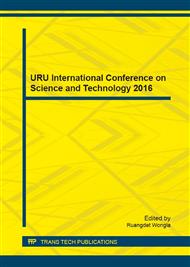p.3
p.9
p.15
p.22
p.26
p.31
p.37
p.42
Checking Adulteration of Aromatic, Amylose Content and Glutinous in Rice by Using Molecular Marker
Abstract:
The purification of rice varieties were tested by using molecular markers. DNA fingerprint is the most accurate method. This research was extracted single milled rice seed varieties, which includes Proteinase K in SDS extraction buffer and 2x CTAB. Three simple sequence repeats (SSRs) markers for varietal purity test are 1) BO3, which completely co-segregate with the rice grain aroma. This primer pair amplifying a 140 bp fragment for an aromatic variety, KDML105 and a 130 bp fragment for a non-aromatic variety, RD29, 41, 49 and rice berry, respectively. 2) RM190, which is closely linked to waxy gene. This primer pair amplifying a 125 bp fragment for low amylose content, Sao-hai, RD 29, RD 41, RD 49 rice varieties and a 110 bp fragments for high amylose varieties, rice berry, KDML 105 and 3) Glu23, which is glutinous marker. This primer pair amplifying a 196 bp fragment for a non-glutinous variety, RD 29, RD 41, RD 49, rice berry and a 225 bp fragments for glutinous varieties, Keaw-Ngoo sticky rice. All markers can be checking adulteration of aromatic, amylose content and glutinous in rice by using molecular Marker.
Info:
Periodical:
Pages:
22-25
Citation:
Online since:
October 2016
Authors:
Keywords:
Permissions:
Share:
Citation:


